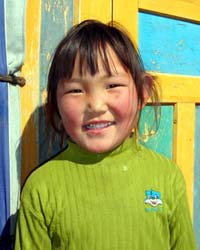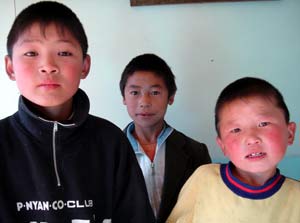Future of open and distance learning in Mongolia
15-12-2005 (Ulan Bator)

Future beneficiaries of ODL in Mongolia: School girl in remote Khuvsgol aimag of Northern Mongolia
© UNESCO
An efficient open and distance learning system in Mongolia requires strict coordination and commitment to common conceptual and technological approaches said the participants of a national conference in Ulan Bator during the UNESCO Week in Mongolia last month.
The Conference (2-4 November 2005) was designed to provide an overview of various national and donor initiatives in life-long learning, secondary and higher education, both at central and aimag (province) level. Experts from the government and donor agencies, major ICT and education establishments, education consultants, researchers and practitioners presented a wide array of projects, from distribution of laptops in dormitories to various assessment studies to private MBA courses.
Four years after completion of the “Learning for Life” project in Mongolia, UNESCO took a lead again in drawing attention to the urgent need to assess and cross-reference numerous un-coordinated initiatives, which filled in the vacuum after the end of the project.
According to data provided by the Ministry of Education, Culture and Science of Mongolia, the national education system is to benefit US$110,000,000 in grant allocation during the period of 1997-2008 and US$55,000,000 in loans for 1997-2011.
Given Mongolia’s relatively small population of 2,7 million people and a healthy envelop of US$ 165,000,000 in external aid, the national authorities should be able to ensure adequate learning opportunities to everyone. Yet, during the Conference educational methodologists from remote aimags raised concerns about the lack of books, especially in minority languages, lack of infrastructure and pointed out at the discrepancy between the investment in high-tech as well as consultant services, and the outcome at the grassroots level.
The national E-Mongolia Programme, which was presented by the Information and Communications Technology Authority at the Conference, was considered too generic and broad, lacking the practical action plan and understanding of the situation on the ground by the audience.
However, one tangible outcome of such programme - Mongolia’s first “Education Channel” TV, which is expected to cover all 21 aimags and 680 schools - was welcomed as a very positive development. Another topic which steered vivid debates was the choice between commercial or free and open source software for future ODL systems. The general conclusion of the conference was that the establishment of a sound interoperable ODL system in Mongolia requires a strict coordination discipline and commitment to a common conceptual and technological approach.
As the output of the Conference, a draft version of ODL organizational matrix and recommendations to the Government of Mongolia is being produced collectively by all the participants. The matrix is expected to provide a time-table and division of labor in developing common standards for ODL policies, content development, infrastructure and human resources. It is hoped that consolidation and synergy of existing ODL initiatives will contribute to the achievement of strategic national targets, as set out in the “ICT Vision 2010 in Education Sector of Mongolia” and the “ICT Action Plan of the Education Sector of Mongolia by 2004”.
Four years after completion of the “Learning for Life” project in Mongolia, UNESCO took a lead again in drawing attention to the urgent need to assess and cross-reference numerous un-coordinated initiatives, which filled in the vacuum after the end of the project.
According to data provided by the Ministry of Education, Culture and Science of Mongolia, the national education system is to benefit US$110,000,000 in grant allocation during the period of 1997-2008 and US$55,000,000 in loans for 1997-2011.
Given Mongolia’s relatively small population of 2,7 million people and a healthy envelop of US$ 165,000,000 in external aid, the national authorities should be able to ensure adequate learning opportunities to everyone. Yet, during the Conference educational methodologists from remote aimags raised concerns about the lack of books, especially in minority languages, lack of infrastructure and pointed out at the discrepancy between the investment in high-tech as well as consultant services, and the outcome at the grassroots level.
The national E-Mongolia Programme, which was presented by the Information and Communications Technology Authority at the Conference, was considered too generic and broad, lacking the practical action plan and understanding of the situation on the ground by the audience.
However, one tangible outcome of such programme - Mongolia’s first “Education Channel” TV, which is expected to cover all 21 aimags and 680 schools - was welcomed as a very positive development. Another topic which steered vivid debates was the choice between commercial or free and open source software for future ODL systems. The general conclusion of the conference was that the establishment of a sound interoperable ODL system in Mongolia requires a strict coordination discipline and commitment to a common conceptual and technological approach.
As the output of the Conference, a draft version of ODL organizational matrix and recommendations to the Government of Mongolia is being produced collectively by all the participants. The matrix is expected to provide a time-table and division of labor in developing common standards for ODL policies, content development, infrastructure and human resources. It is hoped that consolidation and synergy of existing ODL initiatives will contribute to the achievement of strategic national targets, as set out in the “ICT Vision 2010 in Education Sector of Mongolia” and the “ICT Action Plan of the Education Sector of Mongolia by 2004”.
 Future beneficiaries of ODL in Mongolia: Darkhad girl in remote Khuvsgol aimag
Future beneficiaries of ODL in Mongolia: Darkhad girl in remote Khuvsgol aimag© UNESCO
 Future beneficiaries of ODL in Mongolia: School boys
Future beneficiaries of ODL in Mongolia: School boys© UNESCO
Related themes/countries
· Mongolia
· ICT in Education: News Archives 2005
Share this story:














